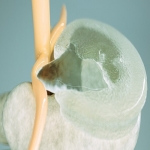Radiculopathy, Cervical, & Lumbar Root Impingement
What is Nerve Root Impingement?

When the nerve roots that split from your spinal cord become pinched or damaged within the spine this is called radiculopathy. The three kinds are cervical, thoracic, and lumbar radiculopathy. This can create pain, weakness, or numbness and tingling. Cervical radiculopathy occurs when a nerve root is compressed in the neck (cervical spine).
Thoracic radiculopathy occurs in a similar way within the upper back (thoracic spine). This is the least common location for radiculopathy. Lumbar radiculopathy occurs in the lower back (lumbar spine), this is also called sciatica. This is because the nerve roots that make up the sciatic nerve can be involved. Radiculopathy most frequently occurs in this area.
What is Nerve Root Impingement Caused By?

Radiculopathy can be caused by changes within the bone structure of the spinal vertebrae, tendons, and intervertebral discs. If these shift or change size in anyway this can narrow the openings where the nerve roots travel inside the spine or exit the spine. These openings are called foramina.
Signs and Symptoms of Nerve Root Impingement
Compression of the nerve root can cause it to become inflamed. Some symptoms may include sharp pain that worsen with certain activities, weakness or loss of reflexes, and numbness or “pins and needles” feeling, otherwise known as paresthesia. If one experiences any pain, weakness, or numbness and tingling in their arms and hands this can be due to cervical radiculopathy.

Experiencing pain and numbness that wraps around the front of your body can stem from thoracic radiculopathy. The “pins and needles” feeling or numbness and tingling that goes from the low back, down the buttocks and legs can be stemming from sciatica or lumbar radiculopathy.
Diagnosis and Treatment of Nerve Root Impingement
A physical exam as well as additional testing may be done to test your muscles strength and reflexes to help diagnose radiculopathy. Pain with particular movements may allow doctors to identify the affected nerve root. Imaging can also be used to identify the structures of the spine that may be causing the symptoms.

Nerve conduction studies can isolate whether the problem is neurologically or muscularly linked. Treatment includes medication like anti-inflammatories or muscle relaxers, weight loss if this is linked to one’s radiculopathy, physical therapy to treat or used preventatively, or steroid injections to reduce inflammation and relieve pain.
Resources:
https://www.hopkinsmedicine.org/health/conditions-and-diseases/radiculopathy
Related Physicians
The providers at Kansas City Bone and Joint Clinic each have their own areas of specialty. Click on the providers below to read more about them.


